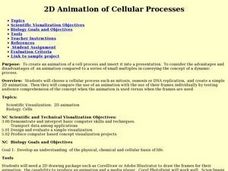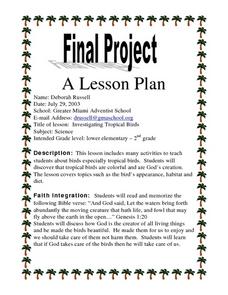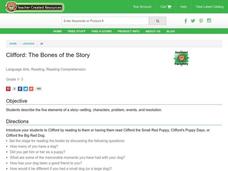Curated OER
Elements of Design
Students define basic design vocabulary. They examine fabrics and sort into similar piles, design a picture of a beautiful room and label each art element in the design. They read an article from an interior design magazine and summarize...
Curated OER
2D Animation of Cellular Processes
Students create an animation of a cell process and insert it into a presentation. They choose a cellular process such as mitosis, osmosis or DNA replication, and create a simple 2D animation.
Curated OER
An Anecdote is Worth a Thousand Pictures
Students identify anecdotes in speeches and the purposes that politicians use the anecdotes for. They create personal anecdotes for the class to hear, and students decide if the anecdote is real or fabricated.
Curated OER
So You Think You Got A Problem
Young scholars find alternatives to conflicts that they, may confront in their everyday lives Through the use of literature, students are given opportunities to use parallel tasks that will instruct them on how to identify and correct...
Curated OER
Investigating Tropical Birds
Learners investigate tropical birds. They write letters for rain forest preservation to protect tropical birds. They interview a bird professional from a local bird store or a zoo and discuss how to take care of a parrot. They use Kid...
Curated OER
Pictures in Words: Poems of Tennyson and Noyes
Students analyze poems by Tennyson and Noyes. They identify examples of alliteration, onomatopoeia, personification, metaphor, and simile. Students create examples of alliteration, onomatopoeia, personification, metaphor, and simile.
Curated OER
Run-on Sentences
In this grammar worksheet, young scholars correct 5 run-on sentences. For example, "The most important part of college is being well-prepared for tests because if you don't do well on tests then won't get a good mark..."
Curated OER
Rice and More Rice
Fifth graders explore problem solving strategies for mathematical estimation. In this math problem solving lesson, 5th graders predict how many grains of rice are in a jar, practice establishing and looking for patterns in...
Curated OER
And the Moral Is...
Students complete a unit using Aesop's fables to learn about morals and insert them into their everyday lives. In this moral values lesson, students complete four lessons using various Aesop's fables.
Curated OER
Poetry Alive! Interpreting Poetry Using Digital Images
Students investigate poetry by incorporating images into the words of a poem. In this language arts lesson, students discuss poetry writing devices and self expression with their classmates. Students create a film about the poem by...
Small Planet Communications
Civil War
Students discuss political, social, and personal issues relating to the Civil War from various perspectives using internet sources. Students write various selections from Civil War characters' point of view.
Curated OER
Ancient Greece Across the Curriculum
Sixth graders explore Ancient Greece using resources in literature, math, social studies, and science.
Curated OER
The Bones of the Story
Young scholars describe the five elements of a story--setting, characters, problem, events, and resolution. They use the Clifford series of books, and a worksheet imbedded in this lesson to help them explain the five elements of a story.
Curated OER
The Heart
High schoolers identify the parts of the heart and the path blood flows through it. They practice using new vocabulary and labeling the parts of the heart. They examine the path of oxygenated and deoxygenated blood as well.
Curated OER
Cartoon-Truth or Tale
Students analyze efficacy of visual representations when accompanied by narratives, explore power of suggestion from symbolism, examine how artists use color to convey messages, and research locations on Internet to comparison and contrast.
Curated OER
Poetry to the Core
Second graders examine several examples of poetry in the six lessons of this unit. The lessons focus on five poetic forms, couplets, quatrains, limericks, Haiku, and free verse.
Curated OER
Fantasy, Fables, Myths, Legends & Fairy Tales
Students identify the differences between fantasies, fables, myths, legends and fairy tales. In groups, they create their own versions of the different genres. They practice identifying the examples, as well.
Curated OER
On the Line
High schoolers view a television program that traces the use of the assembly line in mass production and the subsequent conflict between workers' rights and management. They analyze and discuss the portrayal of the American worker over...
Curated OER
Senses, Spaces And Structure
Students develop greater ease with their bodies and their personal environments.
They extend body space into its immediate architectural boundaries and draw a simple yet detailed floor plan of a physical space or structure (bedroom,...
Curated OER
PICTURE READING - PARAGRAPH WRITING
Students investigate the elements found in a media image. The image is used to compose a descriptive paragraph. They exchange papers to discuss the writing and make changes using constructive criticism. Students also make connections...
Curated OER
Bottled Model Lungs
Students will learn about the respiratory system by comparing and contrasting models, building their own models, and giving one another feedback. Questions about familiar body systems can be useful in getting students to start thinking...
Curated OER
Jingles Sell
Students explore the different persuasive techniques used in commercial and print advertisements. Students then analyze a variety of print ads and discuss the effects of a country's political, economic, and social climates on its...
Curated OER
Impromptu and Extemporaneous Speeches
Learners brainstorm and agree on a topic that is interesting to both the speaker and the audience and research it with both tradition and non-traditional sources. They write and outline the body of the speech and translate the speech...

























